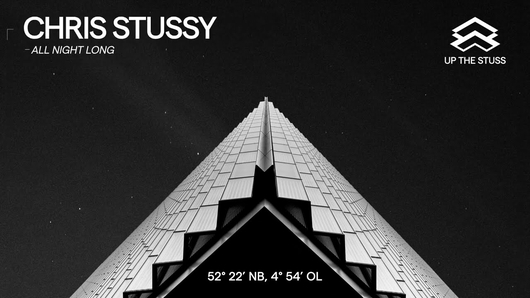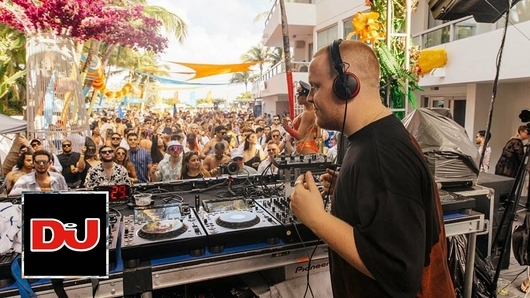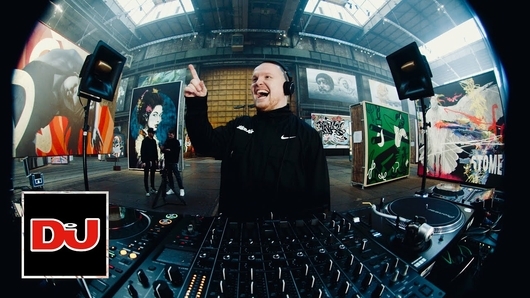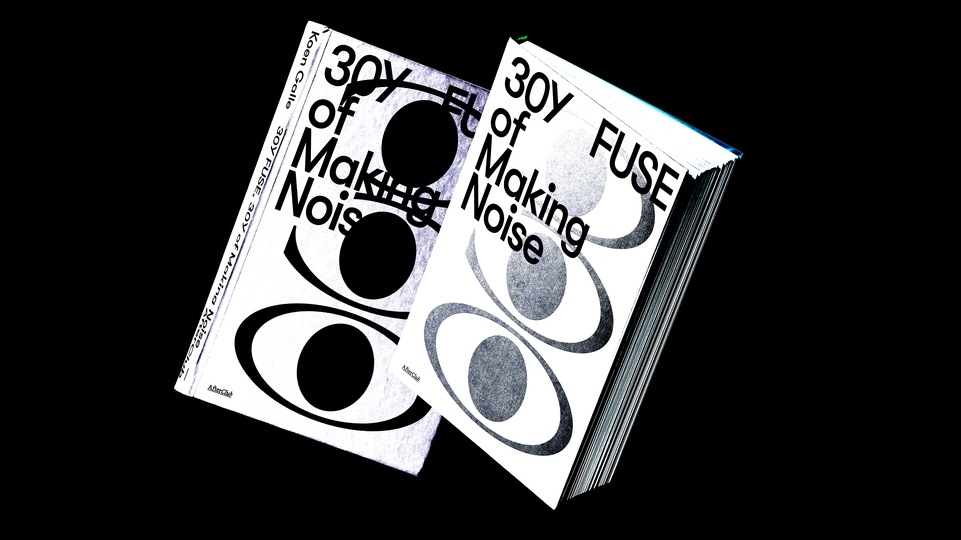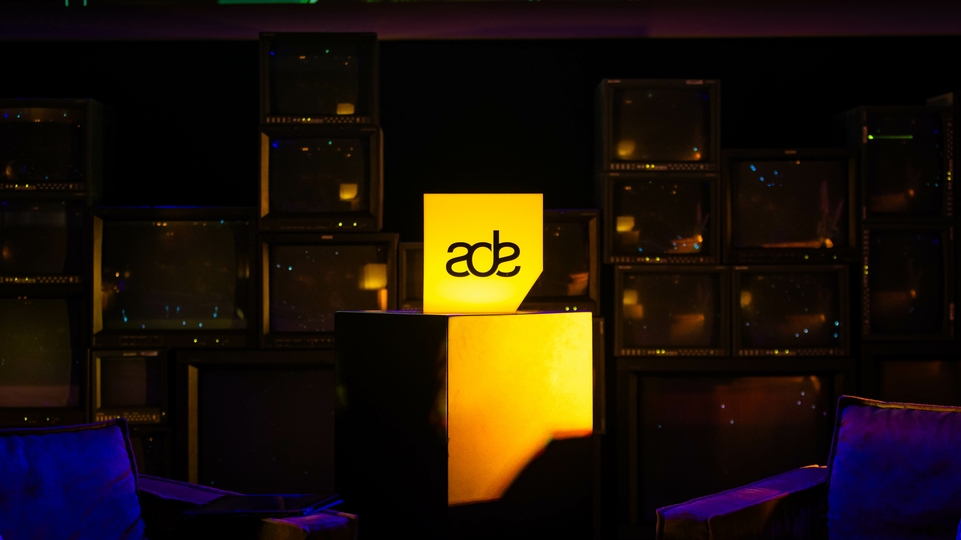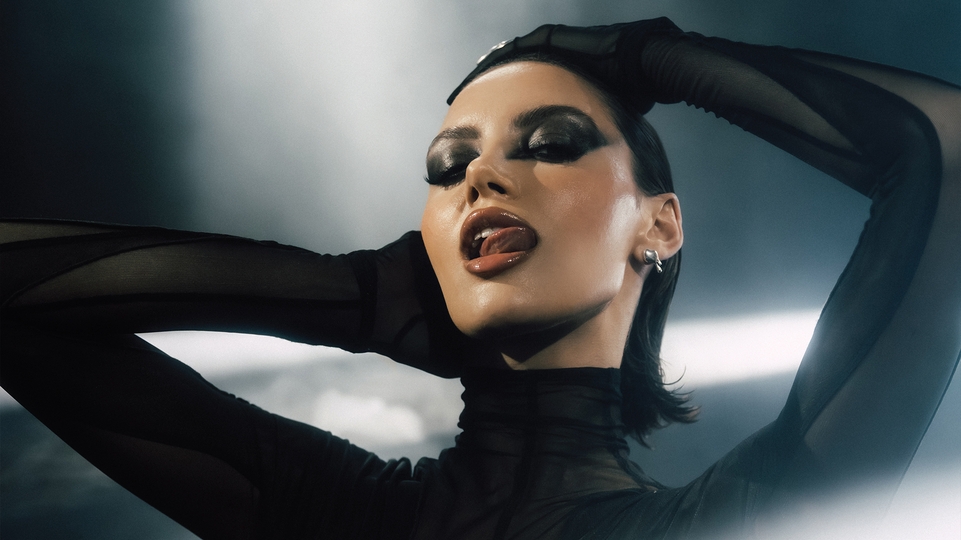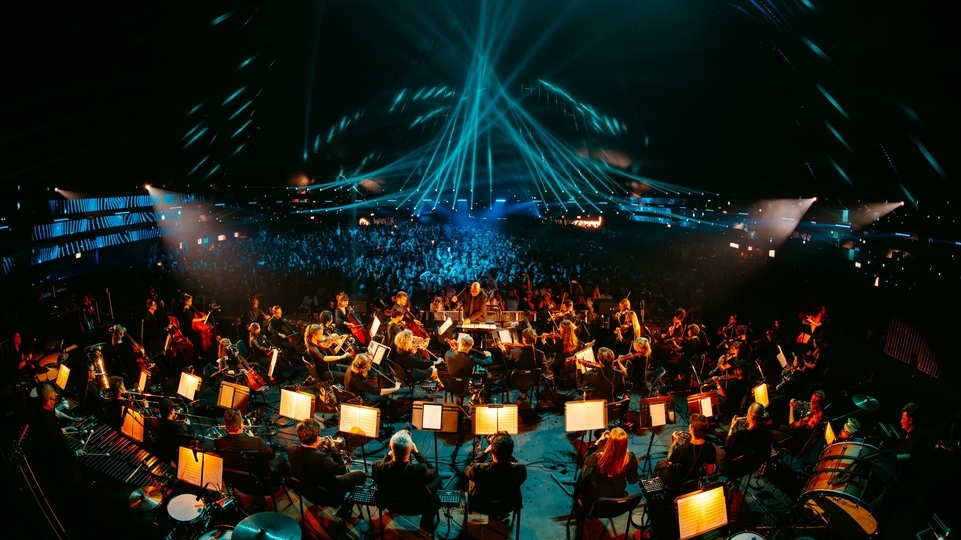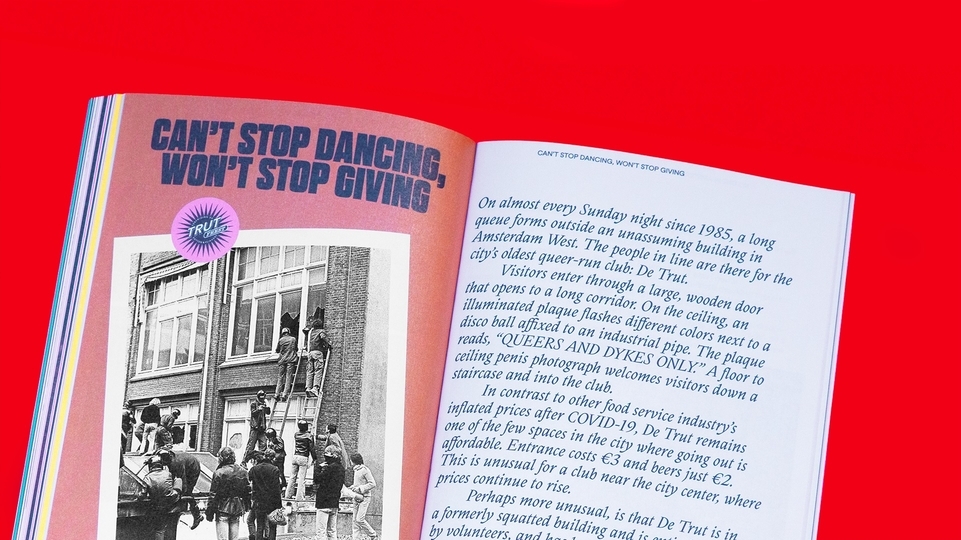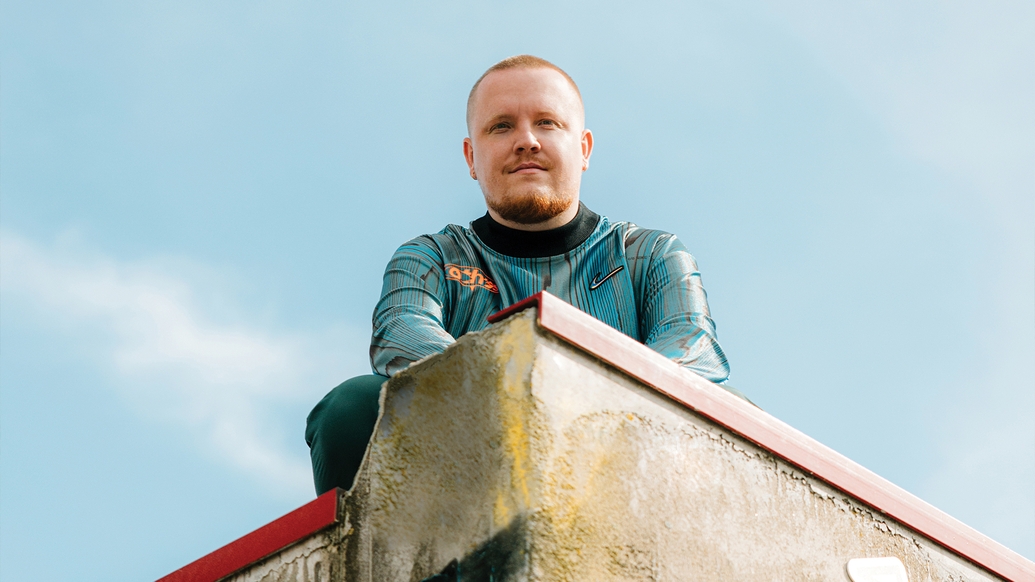
Chris Stussy: house music all night long
A flagbearer for the Dutch house scene, Chris Stussy ascended to the next level this year with his hit, ‘All Night Long’. A tirelessly creative DJ, producer and curator, this month he speaks to Anna Wall about his history in music, his time spent as a footballer, his global fanbase, and more
It’s a sunny afternoon in Amsterdam, with brilliant blue skies and nothing but a few sparse clouds in sight. Pelotons of cyclists ride calmly and somewhat silently through the streets, over the quaint canals and leafy avenues, the quiet interrupted with the occasional tram passing by. It’s nearing the end of the summer, and today it’s a welcome 24 degrees.
We arrive in Amsterdam’s Oud-West, a delightful and peaceful neighbourhood that Niels Steenbergen, AKA Chris Stussy, calls home. He greets us with a smile at the door of his new house of two months, and we settle at the table with an iced tea. It’s a beautiful space; his vinyl collection is organised neatly by the turntables set up in the living room, which overlooks a picturesque balcony. Natural light gleams through the windows, and downstairs he’s created a home studio. For Stussy, it’s the perfect sanctuary.
The 29-year-old Dutch DJ and producer is one of the most prominent names representing the new wave of groove-led house music that’s been emanating from the Netherlands in recent years. Stussy’s sound is one that he’s been crafting over the past decade, with a consistent flow of productions that have gained him a dedicated and fast-growing fanbase, with early releases on widely respected labels such as legendary New York imprint Nervous Records. In recent years, he’s further refined his take on house music with records for distinguished Parisian label Yoyaku and Kerri Chandler’s Kaoz Theory, as well as through curating his very own imprint, Up The Stuss.


Earlier this year, his single ‘All Night Long’ became an overnight sensation; starting out as a certified club hit, after hundreds of frenzied ID requests it quickly became a summer festival anthem too. From its first play on a live stream in March, which clocked up over 640,000 plays, to over 5 million streams on Spotify to date, somehow this feels like it’s just the beginning. “This is at Creamfields, 20,000 people. This is why they call it the runway... it’s like above the crowd, super trippy for people,” Chris explains, showing us a clip on Instagram of where he’ll be playing soon.
Spinning in front of large crowds like this has become second nature to Stussy; he feels just as comfortable on a festival stage in front of thousands as he does in the booth of an intimate 600-capacity club, and often will seamlessly transition between the two in one weekend. We’ve caught him at an opportune moment in between his travels; yesterday he returned from Sonus Festival in Croatia, and tomorrow he heads to play DC-10 in Ibiza for a B2B with PAWSA, before flying to the UK to play at Eastern Electrics, LAB11 and Creamfields. It’s been a whirlwind summer for Stussy but he’s far from tired; in fact, he’s full of enthusiasm and more inspired than ever.
Stussy grew up in Leiden, a municipality in South Holland near the coast that’s 30 minutes drive from Amsterdam and Rotterdam. A picturesque destination with 16th-17th century architecture and near sandy beaches, it’s also known for its nightlife as a student city. However, his first introduction to dance music was long before he’d entered a nightclub, via his parents’ eclectic music collection and a series of mix CDs. “At home, mum and dad were listening to jazz and trance, stuff like that. There was this DJ called Ben Liebrand making CDs with super-cool house, ’90s stuff which I always used to listen to. We’d load it up into the computer, you know, these old school speakers next to the screen. That’s how I was listening to music when I was 13 or 14.”
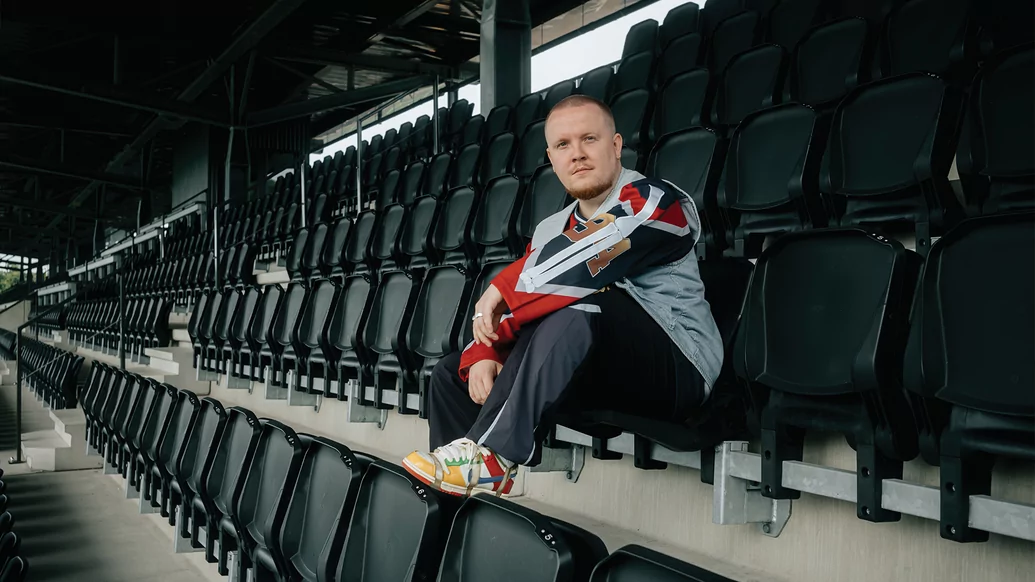
“When I enter a club and someone is opening properly... I still get goosebumps thinking about it. Because for me it’s the most important set of the night, and when the person who is opening is doing it right, it just gives the whole night the breathing space it deserves.”
At the time it wasn’t that he wanted to become a DJ or anything — it was just him listening to music while playing FIFA. “I was always into being a professional footballer instead of going out. That came afterwards,” he explains. When he was younger, Chris played for the Haarlem youth academy football team. After a year on the pitch, HFC Haarlem became defunct, and Chris went back to his former team UVS in Leiden.
“At that point, I was also getting into going out more and DJing a little bit in my friends’ back gardens and at birthday parties, you know, so that’s the funny thing. Things were slowly picking up from that point and got more serious as time went by. I joined a booking agency when I was 19. One day I had to choose between playing a football match and playing my first gig at Straf_Werk festival. I remember it like yesterday, my mum advised me that if I wanted something really badly, I should focus on one thing and give it my everything. I ended up playing the festival that day, and that was the point that I made the decision and started focusing on music 100%,” remembers Stussy.
When his team in Haarlem was prematurely liquidised, it put Chris’ dreams of being a professional footballer to the side and his focus shifted to music. It was at home in Leiden that he began his first DJ residency. “I started out there playing bars. I was a resident DJ at the beach club in Noordwijk, where I played everything,” he says. “It was a really long night of five or six hours, and I was still going to school. I could learn everything; I was playing hip-hop, which is way harder. You mix in a different way, and you learn the techniques of how to do it, you switch from a hip-hop track to a house track, and then back. You learn how to DJ because you play for five hours straight.”
The skills he developed came into good practice over the years, learning the art of the warm-up in different clubs and spaces before he eventually started being booked for peak-time. “When I enter a club and someone is opening properly... I still get goosebumps thinking about it,” he says. “Because for me it’s the most important set of the night, and when the person who is opening is doing it right, it just gives the whole night the breathing space it deserves. Every club deserves it.”
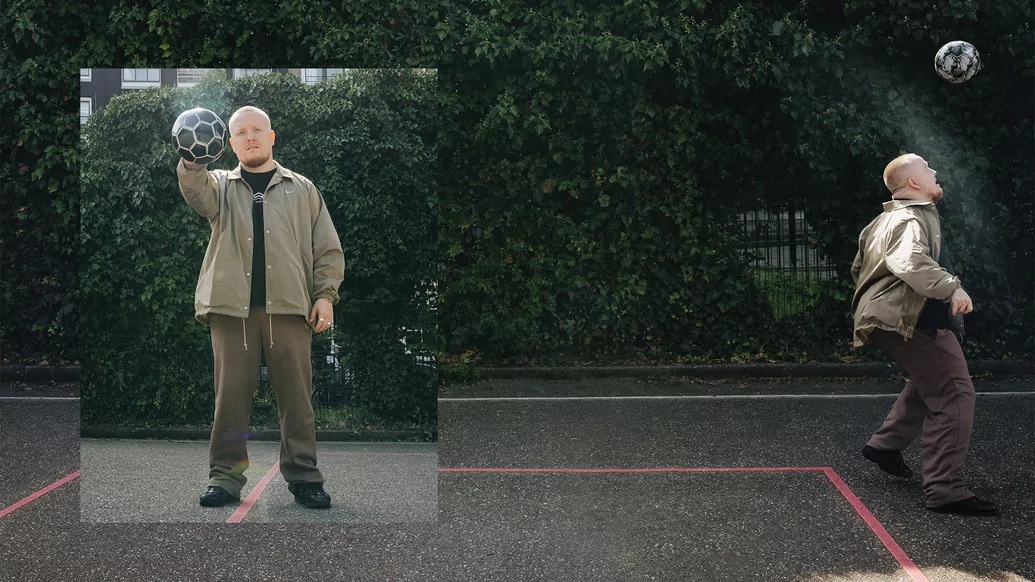
Discovering the house music scene in neighbouring cities like Amsterdam happened long before he moved there five years ago, and it was a turning point for Stussy. He looks back at the memories affectionately, regarding them as a very influential time in his life. “I met a few guys that were really into the minimal sound. So back in the day we were going to Studio 80. We were going to parties from Slapfunk, Daan Groeneveld and Alex Salvador’s Tomorrow Is Now, Kid!,” he remembers.
“You had minimal like Slapfunk and VBX, then you had these guys from Tomorrow Is Now, Kid!, they were blending minimal with ‘90s classic house in an old school way. That’s my sound, I was going between the two all the time. I was intrigued with these guys like Fabio Monesi, Brawther, Jeremy Underground, Daan Groeneveld and all those old school underground DJs. This was the time that I discovered the underground in Amsterdam. I wish I could go back to those times, actually,” he adds.
Ten years ago, it was all about dark nightclubs and no phones. As well as the now defunct Studio 80, he was frequenting spots like Club Poema and Club Lux in Utrecht, a venue situated next to the canal now known as Basis. It was before the explosion of cameraphones; aside from the occasional Facebook group for track IDs, phones were left in your pocket, Stussy remembers. He was also visiting local record stores, unearthing new music, and the weekend experiences were a prominent source of inspiration for his music making.
“I’ve been listening to house music since I was 15 years old, so that’s like 14 years ago now. How I see it is you go in a circle of 10 years, and once you’ve been through that circle, you can really feel what’s close to you.” He pauses for thought. Stussy still remembers the day that he discovered US house legend Kerri Chandler, and how enamoured he was by his music, delving into his long-spanning discography via Beatport and YouTube. “Every track that I was clicking after that, this algorithm... once you are in a good algorithm and you know some artists, then you start digging. That’s how you develop your sound.”
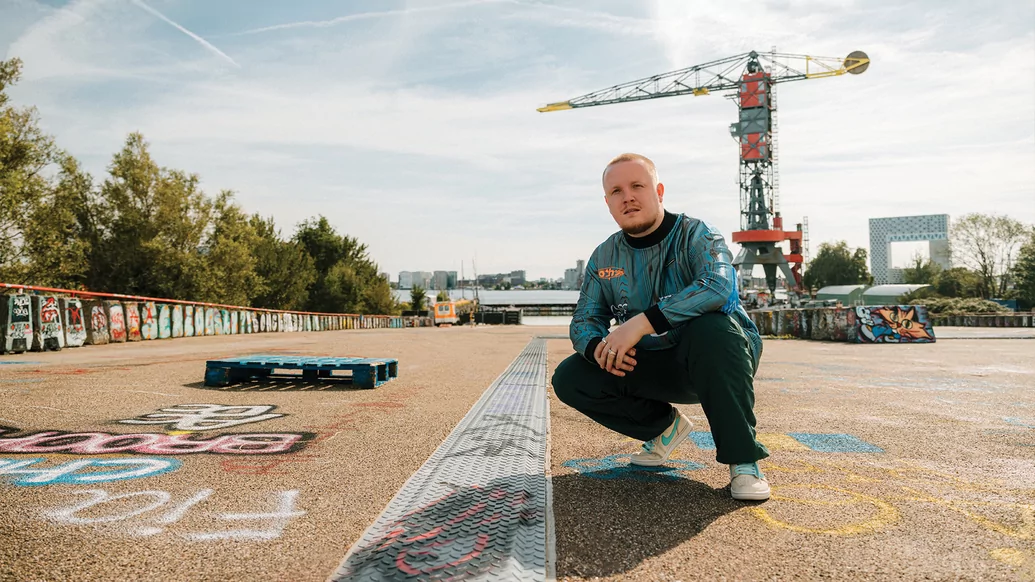
“I never ask someone to send me four tracks and release them and that’s it, that’s not how I work. For the release with Fabe I think we took a year before the EP finally shaped up.”
Stussy had been a DJ for two or three years before he began to explore music production, using the programme that he still uses today — FL Studio. Stussy’s earliest EPs came on labels like Nervous and PIV Records, channelling the spirit of classic deep house, with tempos that were considerably slower than what he makes and plays today. He was creating productions designed for his opening sets, and as he started getting booked for the second slot of the night, his music naturally began to develop to be slightly pacier.
While he continued to craft his sound, it was becoming clear that all his music, regardless of the tempo, had one thing in common — a penchant for groove. By 2018 his releases sounded warm, effortlessly groovy, often deep and dubby, embellished with glimmering pads and dancefloor-friendly, skippy breakdowns. By 2019 he had an abundance of vinyl out on the racks and his music could be heard on DJ Steaw’s Rutilance, Politics Of Dancing, and French producer Djebali’s label, amongst others.
In 2020, during the pandemic, he launched Up The Stuss: a platform to release music of his own, as well as close friends, emerging artists, and an opportunity to further develop his A&R expertise. The name was inspired by a tour in Australia earlier that year, when his fans began sharing the hashtag #Upthestuss. “It’s amazing because I was like, ‘What the hell do I name my label?’ — and they named it for me,” he laughs. “Then we finalised the logo...” He pauses for a moment to reveal the label’s emblem tattooed neatly on his forearm. “It’s a positive saying, you know, like bringing a party to light, or a track bringing the upper vibes. That’s the kind of feeling I wanted to go with.”
The artwork runs with a similar concept, images taken of the uppermost abstract angles of buildings and sky-high architecture. He certainly has an eye for it, too; with a passion for photography, he loves to take photos in his spare time and during his travels. His portfolio is vast, capturing images of New York city skylines, Miami streets, Ibiza sunsets, and the pyramids of Giza.
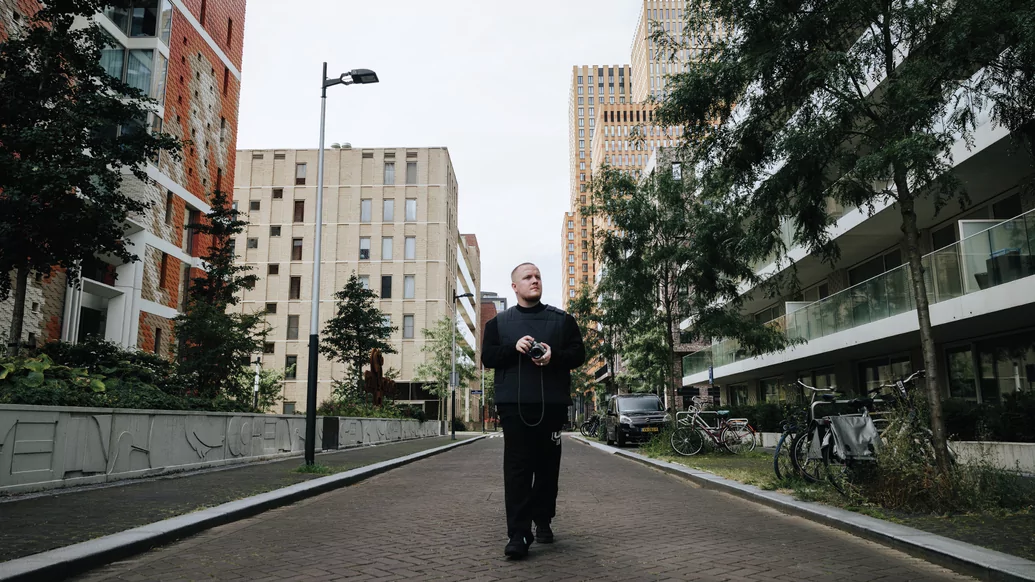
The label artwork is made up of photographs he’s captured on the road using his Fujifilm 35mm camera, and from other photographers that he admires. Each record includes co-ordinates that relate to where the artist lives at that moment. He heads over to one of the neatly organised vinyl cabinets, and draws out three records. “So for example with Fabe...” He points to the cover of the first release. “...at this moment he lived in Mannheim. A year ago he moved to Berlin, so if we were to do another one, he would have different coordinates.”
Over the past three years the label has released records by East End Dubs, Janeret, Locklead, Kolter (FKA DJOKO), Malin Genie and many more. They are artists that Stussy considers dear friends, and he takes pride in working closely with everyone to shape each release with the knowledge of what will suit the vibe and the direction of the label. “I never ask someone to send me four tracks and release them and that’s it, that’s not how I work. For the release with Fabe I think we took a year before the EP finally shaped up. I told him, ‘You’re gonna be the first release’, so we had the artwork and title track done, but I can be really picky when it comes to the final track to complete an EP.”
“It can be hard for someone to really nail that, because there’s a little bit of pressure, so at one point I said, ‘Let’s take off the pressure’, and after one week he nailed it. What I tend to do now is let them make music, like a bunch of seven or eight tracks and then I cherry-pick from them. With the Malin Genie EP, we met up in my studio and he came over with like 30 drafts. We listened to them all and I was like, ‘OK, I like these six’. In the next half a year he finished them all, sent them to me, I played them and I was like, ‘OK, I think we have a package now’. So it’s a different kind of approach to getting an EP together.”
Label owners have certain criteria when deciding what to release on their imprint — what does Chris look for when signing a record? “I like to hear something new,” Stussy replies, matter-of-factly. “I’m not looking for something that you can already hear on previous releases. I’m looking for something that gets me on my toes. When I hear something new, and I love it by the first listen... you never forget that first time. When someone sends me a track, for example ‘One Take In The Booth’ by Fabe, I first heard it as a snippet of two minutes and I was like, ‘You need to finish this, man; I love this’. These moments are really precious for me.”

His musical relationships and close friendships have built naturally over time, and he’s truly passionate about supporting the artists that he loves; from playing their records in his DJ sets and releasing their music on the label, through to gig opportunities. “I like to have a personal connection with someone, and that’s also what happened with East End Dubs, Janeret, S.A.M, and everyone that I have on my label. They are also my friends,” he says. “I would book them, I would push them at my parties that I curate as well, this is also part of helping each other out. You give me four tracks for my label, and know that if I can do something back for you, then I will do it.”
Stussy’s first appearance on his own imprint came as the fourth release, a collaboration with S.A.M of Delaphine Records and one third of Mandar. It was during the second year of the pandemic and S.A.M was living in Berlin at the time, so the pair created the entire eight-track EP remotely. There was synergy between the two and they finished the ideas within a month; the outcome was an EP of uplifting club tracks with catchy melodies, classic house-esque vocals, and musical basslines.
Stussy was able to travel to the USA for gigs while the clubs in the Netherlands were closed, a perfect opportunity to road-test the music they’d been making. The collaboration was released in the summer of 2021, and after that came Stussy’s solo EP ‘Mysteries Of The Universe’ the following year. A set of tracks that fully represented where he was at as an artist, it displayed the expansion of his production techniques, in the form of pacey club tracks with a futuristic edge, cosmic pads and chunky drums, and with a remix from Berlin-based Giammarco Orsini it was supported by DJs across the board.
Another collaboration that he’s been nurturing is one with Utrecht-based producer Wesley Endeman, AKA Locklead, on a project named Across Boundaries. Stussy and Locklead are longtime friends, and met nearly a decade ago. “There’s a photo of us... I’ll show you.” He draws up his phone and reveals a throwback picture of him and Locklead raving it up together. “This is us at the Slapfunk party in 2014. It was at the Blauwe Theehuis at the Vondelpark. It’s an off location, because they don’t usually use it for parties, but for one ADE they did.”

“We’re all in this now and it can be over in two years. I’m really enjoying the moment I’m in, you can’t take anything for granted in the life you are living right now.”
It was there, dancing together in the front row, that the two first properly connected. “Have you ever been to BRET?” he asks curiously. “These are the kind of places both of us went to a lot. I’ve been there front-left so many times with my friends, until the early morning. At this point I was really intrigued by the minimal sound of Slapfunk, and I think at that time we connected well at parties but we never really said ‘Let’s get into the studio’.”
That hook-up came two years ago, around the time that Locklead released his album ‘Square One’ on Up The Stuss. Fast-forward to now and they’ve made around 16 tracks together, some still yet to be released. “We’re good friends, you know, we’re laughing a lot, and when we make music we don’t have to talk much. A few weeks ago we went to a village in the woods and we made five tracks in five days. It was in the east in a place called Enschede.” He shows us a map of the Netherlands on his phone. “It’s near the border of Germany, so it’s super far. A place called De Lutte.”
He points to the map. It’s a small village in the province of Overijssel, surrounded by beautiful nature reserves and forests. “The black line is the German border, so you can imagine how close that was. But for us it was to get out of here, because it can be madness, you know, the daily life. We had our phones off, making music the whole day from 8AM until 7PM. The synergy in the studio was super nice.” Their first show as Across Boundaries was set to be on 15th September at Into The Woods festival in Amersfoort, where they were due to close one of the stages with a three-hour B2B set.

The first release under Stussy's new series UTSOFF was the single ‘All Night Long’, which is undoubtedly his biggest record to date. When it blew up earlier this year it was a career-defining moment, and it still gives him goosebumps thinking about it. “Actually, I had no idea,” he says softly, when we ask him if he could have foreseen the reaction the record has had so far.
He first road-tested the version we recognise now at Printworks in March earlier this year. “It was incredible,” he recalls excitedly, his eyes lighting up at the memory. “It was at the FUSE party. I think it’s also due to the fact that Enzo [Siragusa, FUSE boss] gave me a really nice time slot before him, and he was closing. I played it as my last track. I think for myself it was a nice moment, but I didn’t know what would happen in the next few days, when it exploded and everyone wanted to know the track ID, and that’s where it started to boil a little bit...”
“I’ll tell you a bit of the backstory,” he continues. “It was November and I was in my hotel room in Leeds — I was about to play at Mint Warehouse. My tour manager and cameraman were in the other room and they texted me about our pick-up. I said, ‘OK, I’m just making music right now and I’ll be there at 1.30AM’. I was making this track for 30 minutes and I was like, ‘Oh wow, I think I have something here’. Not knowing how it would go down in the club, I finished it. I made a really simple version, I tested it out and then I left it.”
Two months later, when he was going through music and preparing for his set at Printworks, he stumbled across it again and decided to finish it, adding a vocal and some extra melodies: “It came about so quickly. In like two or three hours I’d made a total song out of it.” The hook is Stussy’s own voice, recorded on his iPhone. “It’s super simple, I recorded it on my phone and I put a vocoder on it,” he recalls. He plays DJ Mag the original recording, still stored in his voice memos.
Two weeks after Printworks he played it again on a live stream, and it was the moment that the track rapidly caught fire across social media. “TikTok was blowing up across the internet. Social media was blowing up with ‘What’s this track?’ and ‘It needs to come out’. It was unreal, there were like 100 videos of people filming the track, people uploading it on SoundCloud. It was getting 50,000 plays a day on uploads from people who had ripped the sound from YouTube and uploaded it. I was like, ‘Guys, what’s happening here? We need to do something’.” Aside from the laborious task of tackling copyright infringements daily, it was a sign he had a big record on his hands.
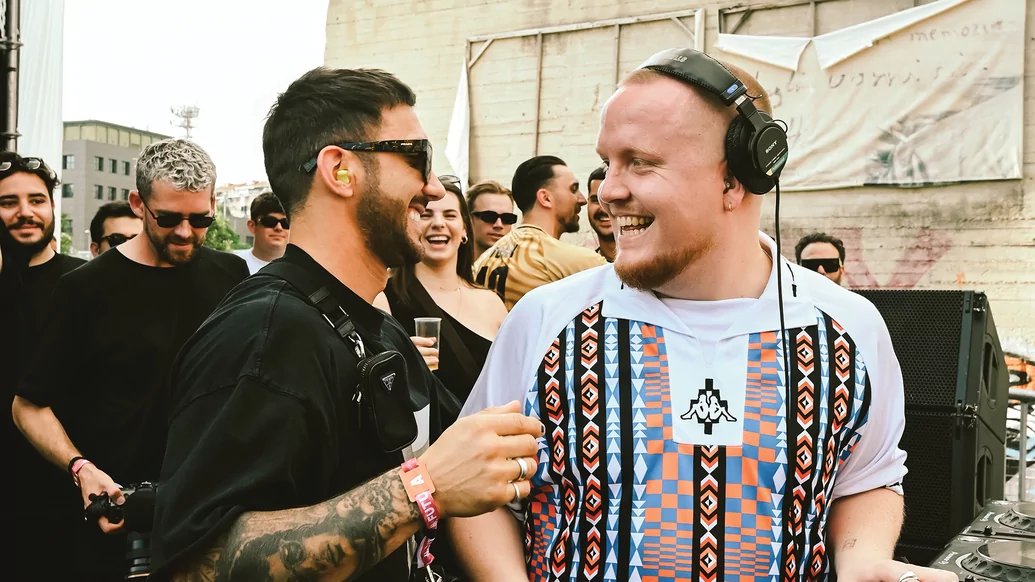
Within 40 days, he’d pressed the record and it hit the stores on 30th May, in perfect synergy with his Chris Stussy (All Night Long) date in London that weekend. “The records arrived on the 26th, just as I was about to leave for the airport. We had the All Night Long party at KOKO in London the next night, and when I played it people were singing along, it was one of the best weekends of my life,” he smiles.
It’s a pretty impressive success story for a track that he made in a hotel room with no professional equipment, and vocals recorded on his phone. Back to the label, and he’s already lined up the next UTSOFF release from Locklead, with a super-catchy lead track called ‘Moon’ that also features Endeman’s own vocals. The series will continue to focus on singles rather than EPs, with a black and white aesthetic for the cover artwork photography, providing yet another outlet to explore.
Stussy’s tour schedule has seen a rapid ascension in recent years, with gigs across Europe, the USA, Australia and South America. With his collaborations, friendships, and ever-growing label he’s created somewhat of a community, and artists such as himself, Kolter and S.A.M have been paving the way for their distinct style of house music and pushing it into new territories worldwide. “We’re all in this now and it can be over in two years. I’m really enjoying the moment I’m in, you can’t take anything for granted in the life you are living right now,” says Stussy with sincerity.
Stussy then takes the time to appreciate how far he’s come in his career so far. We begin to reminisce about some of his favourite moments of the year. This summer he returned to Thuishaven in Amsterdam for a 10-hour marathon set. “It’s something I do every year, it’s super special and this was my fifth time. It keeps getting better and better,” he enthuses. “This year I also did Coachella. It was one of the craziest parties. There were about 150 people when I started, and after 20 minutes there were 2,000, and by the end 4,000 people. The vibe was so, so good.”
He shows DJ Mag a video from his Instagram, and you can see that the crowd is electric. “It was 37 degrees outside. You walk into this tent and it’s fully air-conditioned, when you step outside it was like a heatwave coming into your aura, it was so crazy. You enter this tent and people were really in the vibe from the get-go”.
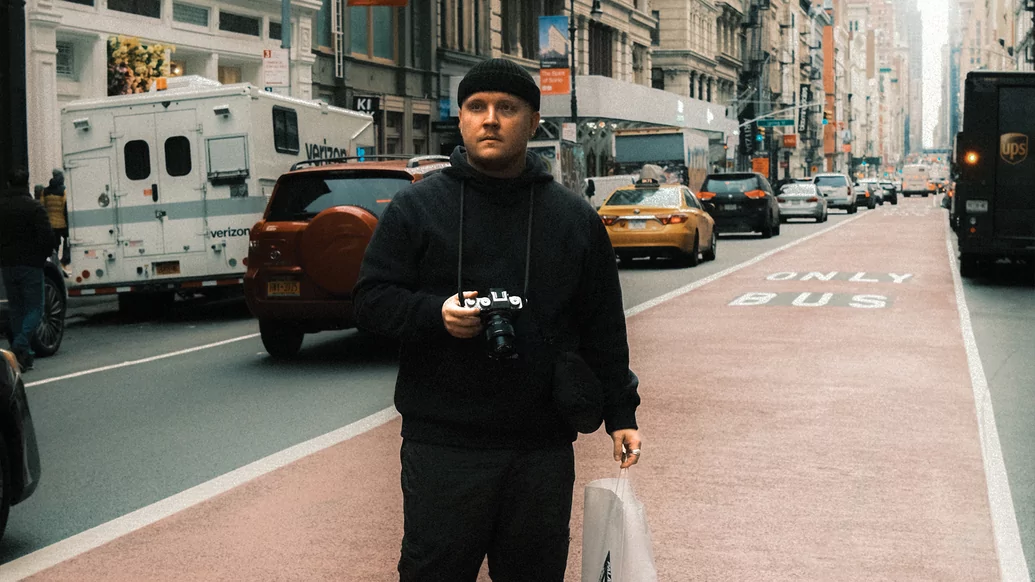
“If I don’t make a track for a month I’m cool with that. I don’t force myself to be behind the computer.”
While ‘All Night Long’ continues to spread far and wide as one of the most prominent club tracks of the year, Stussy is already looking towards the future. He's just released an EP will on Enzo Siragusa’s FUSE imprint called 'Midtown Playground'. Stussy has a long-time affiliation with FUSE and is well accustomed to the sound of the label. It’s perfect timing, as the test presses landed the week of our interview. Stussy fires up one of the turntables to give it a first spin, and we listen attentively through his Yamaha speakers. Tracks like ‘Blueprint’ are deep and intricate, with his trademark skippy, swinging beats and gliding melodies. The A1 ‘Midtown Playground’ is a track he’s been playing in his sets for a while now, already highly anticipated by his fanbase. The music stays true to his underground roots, with tracks that he created especially with the label in mind.
Stussy also has some exciting plans in motion right now. There’s an abundance of new music signed to the label, including an EP coming from London-based Jhobei, a founding member of the Bizarre Trax collective and one third of Felon5. He’s also just launched a new B2B concept that, when we meet, he’s due to test out at Lofi in Amsterdam in September. An all-day event, the plan is to play B2B with each guest: Reeshy, Dan Ghenacia, Fantastic Man, and Locklead. The tickets sold out in 30 minutes. Lofi is a 1,500-capacity warehouse space in the industrial district of Sloterdijk, and since its launch in 2019 has become a welcome addition to Amsterdam’s nightlife.
Stussy checks the time; it’s 2PM and we’ve planned to meet his manager at the club, to check out Lofi’s outdoor space ahead of the event in a few weeks time. It’s a 15-minute car ride, and we leave the tranquil streets and canals of the Oud-West area for the industrial warehouses of the Sloterdijk district. Not far from our destination Stussy points out BRET, the red shipping container illuminated in the sunshine beside Sloterdijk Station. We pass through streets of warehouse buildings until we pull up to Basisweg 63 where Lofi is situated, which was a GVB bus garage before its transformation into a club.
We step outside into the courtyard. Graffiti’d shipping containers create most of the structures, and the DJ booth is situated at the end of a wooden-decked dancefloor, equipped with a Funktion-One sound system. Junkyard-esque art, intriguing sculptures, planted trees and an old helicopter are amongst the oddities to be seen, and it instantly feels like the perfect scenario for a day party. “Everyone plays so differently on this line-up, which I think is really cool,” he says, already thinking about the variation in sets he’ll prepare.
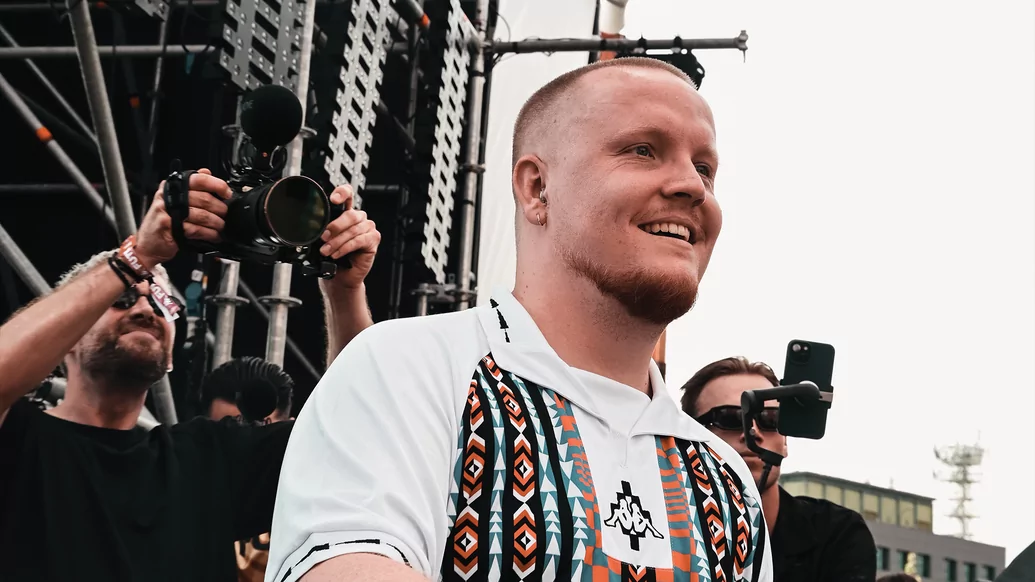
Stussy digs for new music everyday, and it’s still one of his favourite pastimes. “It doesn’t sound like work, but it’s part of my job to listen to new music,” he says. “I buy new records every week. Discovering new music gets me inspired, sometimes I can just hear one certain sound and all of a sudden I’m downstairs in the studio.” Two weeks ago, Stussy took 10 days off in the middle of the summer. It was a much-needed moment for rest and restoration in the midst of his full-on tour schedule.
He doesn’t put pressure on himself to make music, and prefers to allow ideas to flow when the moment comes; whether that be in a hotel room, on his laptop at the airport, or at home. “If I don’t make a track for a month I’m cool with that. I don’t force myself to be behind the computer,” he says.
Appreciating the success of ‘All Night Long’, he feels content and doesn’t feel in a rush to recreate a follow-up. “I don’t want to pressure myself in that way. I just make a track that I feel at that moment. If it’s good it’s good, and if it’s not that’s no problem. It gives me more experience, that’s how I see it. It’s like a process — music is beautiful and can be really frustrating. I learned to keep the frustrating part out of the equation.
“You just make music because you like it, and if other people resonate with it then that’s the most beautiful thing I think there is,” he continues. “Once people start to sing along that’s where you really hit something for people, you know? And that’s something special. You don’t make a track like that every year.”
